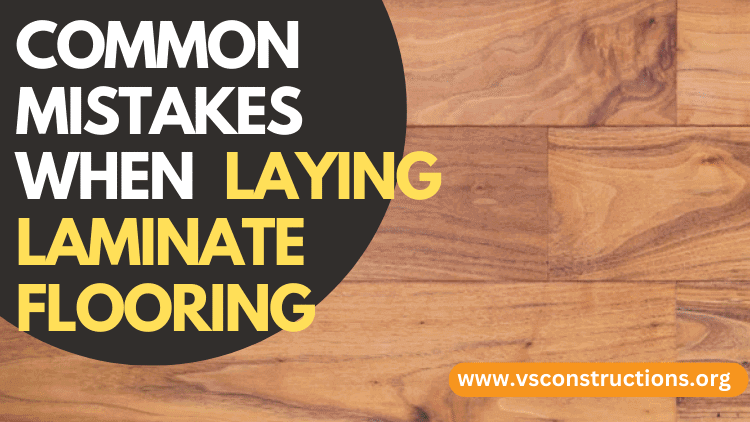5 Issues You May Face When Laying Laminate Flooring (And How to Avoid Them)
Laminate flooring is an affordable and durable option for homeowners who want to upgrade their floors without going bankrupt.
But installing it is not as easy as it seems.
Too many homeowners make costly mistakes when laying laminate flooring. The results include uneven floors, buckling, and warping. That is why it is recommended that you choose professional installation services instead.
But, if you are going to do it yourself, it is best to be aware of the issues you may face.
In this post, we discuss common mistakes made when laying laminate flooring and provide tips on how to avoid them.
Let’s take a look at what they are.
Don’t Make These Mistakes When Installing Laminate Flooring
Installing laminate flooring comes with challenges. Understanding the common mistakes associated with this installation will help you prepare and install better flooring.
-
Not Preparing the Subfloor
One of the most common mistakes when it comes to laying laminate flooring is not preparing the subfloor properly. A subfloor that is uneven, moist, or damaged can cause laminate flooring to buckle or warp.
Before installing laminate flooring, it is important to ensure that your subfloor is clean, dry, and level. Here are some tips on how to prepare it:
- Remove any old flooring and adhesive residue.
- Check for moisture using a moisture meter.
- Fill any holes or cracks with a levelling compound.
- Sand down any high spots.
- Install a vapour barrier if necessary.
-
Choosing the Wrong Underlayment
Another mistake that homeowners make when laying laminate flooring is choosing the wrong underlayment. (This refers to the thin layer of material placed between the subfloor and the laminate flooring. It provides cushioning, sound absorption, and moisture protection.)
Choosing the wrong underlayment can cause laminate flooring to shift or make noise. Here are some factors to consider when choosing the underlayment:
- It should be thick enough to provide cushioning but not so thick that it causes the laminate flooring to shift.
- The underlayment can be made of foam, cork, rubber, or felt. Each material has its pros and cons, so it is important to choose the material that best suits your needs.
- If you live in a humid climate, choose underlayment that is moisture-resistant.
-
Ignoring Expansion Gaps
Expansion gaps are spaces left between laminate flooring and walls, doors, and other fixed objects. These gaps allow the laminate to expand and contract with changes in temperature and humidity.
Ignoring expansion gaps is a common mistake when laying laminate flooring and can cause it to buckle or warp. Here are some tips on how to calculate and install expansion gaps:
- Measure the length and width of the room and multiply them to get the square footage.
- Multiply the square footage by the manufacturer’s recommended expansion rate to get the total expansion gap.
- Divide the total expansion gap by the number of walls to get the expansion gap for each wall.
- Use spacers to maintain the expansion gap while installing the laminate flooring.
-
Installing the Flooring Incorrectly
It is important to follow the manufacturer’s instructions and use the right tools and materials. Here are some tips on how to install laminate flooring correctly:
- Acclimate the flooring by leaving it in the room for at least 48 hours prior to installation.
- Use a tapping block and pull bar to click the planks together.
- Stagger the seams between the planks to create a natural look.
- Use transition strips to cover the gaps between the laminate flooring and other types of flooring.
-
Choosing the Wrong Underlayment
Underlayment is an important component of laminate flooring installation. It helps to cushion the flooring, reduce noise, and prevent moisture from seeping into the subfloor. Choosing the wrong underlayment can lead to problems such as unevenness, noise, and moisture damage.
When selecting underlayment, consider the following factors:
- The thickness of the underlayment can affect the feel and sound of the laminate flooring. Thicker underlayment provides more cushioning and sound insulation.
- Some underlayment materials are better at preventing moisture from seeping into the subfloor than others. If you live in a humid climate or have a concrete subfloor, consider using moisture-resistant underlayment.
- If you live in an apartment or have a room on the second floor, consider using underlayment with sound insulation properties to reduce noise transmission.
Beyond this, neglecting your maintenance can lead to damage and deterioration. Laying laminate flooring can be done DIY to save money while giving your home a fresh new look. However, these common mistakes made by homeowners when installing laminate flooring can lead to concerns down the line. By avoiding these mistakes, you can ensure that your laminate flooring looks great and lasts for years to come.
